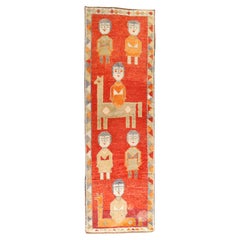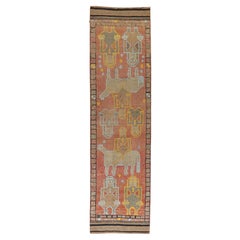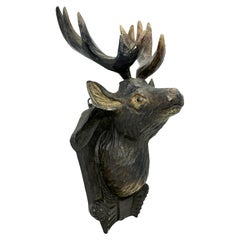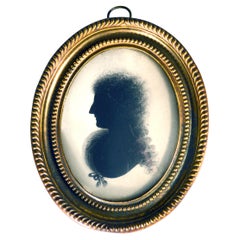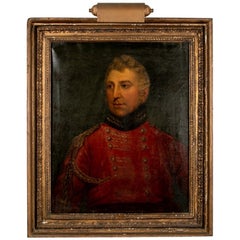USA - Folk Art
21
to
21
17
21
21
21
1,345
558
239
101
86
85
76
50
31
21
20
18
17
11
10
7
3
7
9
5
1
1
10
8
6
3
3
14
13
13
3
3
1
1
Item Ships From: USA
Style: Georgian
Zabihi Collection Red Vintage Turkish Pictorial Anatolian Runner
Located in New York, NY
A decorative one of a kind colorful mid 20th-century Turkish runner featuring 6 humans and 2 animals
Measures: 3'1'' x 9'4''
Category
20th Century Turkish Georgian USA - Folk Art
Materials
Wool
Large 18th Century Leeds/Staffordshire English Creamware Charger or Wall Plate
By Leeds Pottery, Staffordshire
Located in Philadelphia, PA
A fine, very large, 18th century English creamware pottery charger or wall plate.
With a raised feather edge border.
Simply a great antique English pottery...
Category
18th Century English George II Antique USA - Folk Art
Materials
Porcelain, Creamware, Pottery
Antique Woman's Lover's Eye Portrait Miniature Brooch
Located in Downingtown, PA
English Antique Lover's eye portrait miniature brooch.
circa 1840-50
The charming oval-shaped portrait miniature is mounted in a gilt metal repoussé frame with a pin back with a gilt leaf design on each side. The portrait is of a woman's right eye and brow showing ringlets of hair hanging down over her ear.
Dimensions: 1-inch wide x 5/8 inch high x 1/4 inch deep from pin
Reference:
EYE MINIATURES
Eye miniatures or Lovers' eyes were Georgian miniatures, normally watercolour depicting the eye or eyes of a spouse, loved one or child. These were usually commissioned for sentimental reasons and were often worn as bracelets, brooches, pendants or rings with richly decorated frames, serving the same emotional need as lockets hiding portraits or locks of hair. This fad started in the late 1700s and miniaturists such as Richard Cosway...
Category
1830s Georgian Antique USA - Folk Art
Materials
Natural Fiber
Vintage Turkish Pictorial Anatolian Runner
Located in New York, NY
A decorative one of a kind colorful mid 20th-century turkish runner featuring animals and humans
Measures: 3' x 10'11''
Category
20th Century Turkish Georgian USA - Folk Art
Materials
Wool
Massive Antique European Heraldic Wood Carving
Located in Bridgeport, CT
An impressive and well-carved high relief Heraldic Crest in dark stained wood. A pair of fierce rampant lions flank the oval crest with a few fleur-de-lis and labeled Veritas. With a...
Category
19th Century European Georgian Antique USA - Folk Art
Materials
Wood
Exceptional Pair of Dummy Boards
Located in Greenwich, CT
Fine and rare pair of 18th Century English dummy boards depicting a Cavalier and his Lady, he with a Van Dyke mustache, sword and leather boots, she with ...
Category
18th Century English Georgian Antique USA - Folk Art
Materials
Pine, Paint
Antique English Staffordshire Pottery Toby Jug with a Tricorn Hat Lid
By Staffordshire
Located in Philadelphia, PA
A fine antique Staffordshire pottery Toby jug.
In the form of a seated, smiling man holding a jug.
The man's tricorn hat serves as a lid, and an inte...
Category
19th Century English Georgian Antique USA - Folk Art
Materials
Pottery
Midcentury Custom Made Carved Mahogany Urn Table Lamp
Located in New York, NY
A vintage, highly unique table lamp, including double cluster sockets on long brass stems (two pull chains included), above urn form, carved mahogany wood body, with gadrooned detail...
Category
Mid-20th Century American George III USA - Folk Art
Materials
Brass
English Pottery Model of Whieldon Creamware Tortoise-Shell Seated Lion
By Thomas Whieldon Pottery
Located in Downingtown, PA
English pottery model of a lion,
Whieldon-type creamware tortoise-shell glaze,
circa 1765-1785
The English pottery model of a seated lion with a Whieldon-type creamware tortoise-she...
Category
1860s Georgian Antique USA - Folk Art
Materials
Creamware, Pottery
Large Antique English Staffordshire or Prattware Pottery Model of a Cradle
Located in Philadelphia, PA
A late 18th or early 19th century English Prattware baby's cradle in a rare large size.
Decorated with an overall basket weave pattern and a yello...
Category
Late 18th Century English George III Antique USA - Folk Art
Materials
Pottery
18th-Century English Pottery Hearty Good Fellow Toby Jug
Located in Downingtown, PA
English pottery hearty good fellow pearlware toby jug
circa 1800
An unusual variation on the hearty good fellow standing toby jug, The base in white with the Toby figure standing, supporting a large white jug under his right arm, and holding a pipe with his left hand across his chest with his head turned slightly to the left. He has a bright blue jacket and yellow pantaloons with an orange waistcoat. He has a brown tricorn hat...
Category
Late 18th Century English Georgian Antique USA - Folk Art
Materials
Pottery
Antique English Figural Staffordshire or Prattware Pottery Cradle
Located in Philadelphia, PA
A good rare Prattware pottery model of a baby's cradle.
Decorated with orange and blue intersecting circles throughout the body and embellished ye...
Category
Late 18th Century English George III Antique USA - Folk Art
Materials
Pottery
19th Century English Framed Decalomania Découpage & Watercolor Farm Art Picture
Located in Philadelphia, PA
An original British School Decalomania decorative art watercolor and cut paper farm scene mounted in a heavy black wood frame, circa 1860.
These were largely created by young girl...
Category
1860s English Georgian Antique USA - Folk Art
Materials
Hardwood, Paper
18th Century Whieldon-Type Creamware Pottery Cow
By Thomas Whieldon Pottery
Located in Downingtown, PA
Rare 18th century Whieldon-type creamware pottery cow,
circa 1765.
The rare press-moulded cow stands on a flat slab base with lobed edges. The cow is s...
Category
Mid-18th Century English Georgian Antique USA - Folk Art
Materials
Creamware, Pottery
Blue and White Ceramic Chintz Figurine of a Peasant Woman
Located in Oklahoma City, OK
Ceramic figurine of a woman in blue and white glaze. For grand millennials and chintz lovers, this small porcelain figurine will make a superb addition to your blue and white collection. This lovely piece depicts a peasant woman carrying her wares. Her hair is styled in a swept-up style, with a blue glazed hat. Her features are hand-painted in black, with bright red lips. A blue corset...
Category
20th Century American Georgian USA - Folk Art
Materials
Ceramic
Carved 19th Century English Ship's Figurehead of a Classical Male
Located in Essex, MA
Life-size draped classical male ship's figurehead of English 19th century origin. The carving is quite similar to that of the figurehead rescued from the HMS...
Category
19th Century English Georgian Antique USA - Folk Art
Materials
Oak
Set of 24 Painted Papier Mache and Metal Snuff Boxes
Located in New York, NY
This diverse set of early 19th-century English painted snuff boxes, of various shapes and sizes, are finely decorated with a variety of subjects, inc...
Category
1830s English George IV Antique USA - Folk Art
Materials
Metal
Large Antique English Blue & White Staffordshire or Pearlware Cradle Figurine
Located in Philadelphia, PA
A rare, large English pearlware or Staffordshire pottery cradle.
Decorated with an overall basketweave pattern and blue highlights,
circa 1800.
Measures: Length ca. 5 5/8 in...
Category
Late 18th Century English George III Antique USA - Folk Art
Materials
Pottery
Complete English Zebra Wood Backgammon Game Box, Circa 1830
Located in Hollywood, SC
English zebra wood backgammon game box. Game consist of board, two sets of 15 checkers, two pairs of dice, a doubling cube and pair of leather dice cups...
Category
1830s English George IV Antique USA - Folk Art
Child's American Painted Pine Cupboard Completely All Original and Quite Rare
Located in Chicago, IL
Awesome American pine original paint Child's Cupboard finished in a stunning Georgian Blue with glass knobs.
The back board on top of the piece can be removed upon request-- without ...
Category
Early 20th Century American Georgian USA - Folk Art
Materials
Pine, Paint
George IV Painted Puzzle Jug, Dated 1823 with Initials JA
Located in Spencertown, NY
The puzzle jug consisting of a handle with pierced yellow painted decoration above and below the band of three spouts, floral painting on each side with int...
Category
1820s English George IV Antique USA - Folk Art
Materials
Ceramic
Related Items
Black Forest Folk Art Carved Wood Deer Head with Glass Eyes, 19th Century
Located in Nuernberg, DE
A great looking hand carved original wooden Folk Art deer head wall decoration. A great piece for a suitable ambiance in a trophy room or the office of ...
Category
Mid-19th Century German Black Forest Antique USA - Folk Art
Materials
Glass, Wood
H 11.75 in W 5.75 in D 5.75 in
Evelyn Ackerman Animal Wood Carved Panel
By Evelyn Ackerman
Located in Los Angeles, CA
Wood carving by California artist, Evelyn Ackerman, c.1960s. This carving features a hand carved creature.
Dimensions
12.5" width x 9.25" depth x 1" height.
Condition
Good, origina...
Category
Mid-20th Century American Mid-Century Modern USA - Folk Art
Materials
Wood
Exceptional Egyptian Sarcophagus Mask
Located in London, GB
Exceptionally Fine Wooden Sarcophagus Mask
Third Intermediate Period, 21st Dynasty, circa 1069-945 BC.
Acacia wood, rosewood, hippopotamus ivory
Masterfully carved from a single piece of fine-grained hardwood, the present mask is characteristic of the most exquisite funerary art made during the 21st Dynasty, and was probably commissioned for a particularly high-ranking individual.
The oval face displays a gently smiling mouth with full, outlined lips, furrows at the corners and a bow-shaped philtrum. The straight nose with rounded nostrils, the cheeks full and fleshy and the large, almond shaped eyes with heavy lids and tapering cosmetic lines, set below long, sweeping eyebrows.
Social collapse across the Mediterranean in the Late Bronze Age meant that the 21st Dynasty in Egypt was a period of great turmoil. Trade routes were disrupted, governments collapsed, and mass migration occurred. Economic scarcity meant that traditional funerary practices in Egypt were also affected, with a lack of material and financial resources leading to the reuse of preexisting material. As a result, during the 21st Dynasty, 19th and 20th Dynasty coffins changed ownership rapidly and were heavily recycled for new purposes. Tombs were also unmarked allowing them to be shared
by many people. These new practices brought forth a shift in the understanding of funerary paraphernalia. No longer important objects owned forever by the deceased, they were now simply seen as short-term transformative devices, whose symbolic and ritualistic meaning could be appropriated for others. However, paradoxically, the art of coffin-making also reached new heights during this period, and many of the richly dec- orated “yellow” coffins, characteristic of the 21st Dynasty, are remarkable works of art in their own right. Indeed, knowing that coffins were being reused throughout Egypt, the Egyptian élite set themself apart by commissioning lavish sarcophagi decorated with the images and texts meant to help guide them to the afterlife, and which would otherwise have adorned the tomb walls. As coffins were the chief funerary element which now identified the dead and allowed them a physical presence in the world of the living, their quality and appearance were of the utmost importance.
The traditional coffin ensemble was made of three parts: a wooden mummy cover, which laid directly atop the mummy, an inner coffin, and an outer coffin, both made of a lid and case. Additional decorative elements, such as masks, were carved out separately and later glued or pegged to the lids. After the completion of the painted decoration, the sarcophagus was covered in a varnish to give it its yellow colour. Gilding was sometimes used for the coffins of the high priests’ families, notably on parts representing naked skin, such as the face mask. However, some of the élite tactically avoided gilding altogether as to ensure that their coffin would not be looted.
When manufacturing the inner and outer coffins, particular attention was paid to the woodwork. Displaying the skill of the carpenter, this type of funerary art has largely remained unparalleled throughout Egyptian history. The principal wood used to craft the present mask is Acacia nilotica. The evergreen Egyptian acacia was considered sacred and said to be the tree of life, the birthplace of the god Horus, as well as symbolic of Osiris, the god of the dead and resurrection. The modelling of the face in the wood is superb, but the inlays also help mark this mask out as exceptional. Inlaid eyes and eyebrows were extremely rare and reserved to the finest and most expensive coffins. Traditionally, eyes were made of calcite, obsidian, or quartz, and eyebrows of coloured glass paste or bronze. Here, the pupils, eyebrows, and cosmetic lines are inlaid with Dalbergia melanoxylon, a rare type of wood which belongs to the rosewood genus.
In antiquity, however, it was known as Ebony of the Pharaohs, from the Egyptian word “hbny”, meaning dark timber, because of its black, lustrous appearance. An extremely dense and hard wood requiring significant skill to work with, ebony was a luxury material highly coveted by the pharaohs themselves, to make furniture, decorative and funerary objects. The wood was imported with great effort from the southern Land of Punt, most likely modern Sudan, Ethiopia, Djibouti, and Eritrea, alongside other luxury goods such as gold and ivory.
A magnificent ebony throne, recovered in the tomb of King Tutankhamun, illustrates the incredible aesthetic potential of this material and why it was so highly valued by Egyptian royalty. Only élite members of Egyptian society could have afford- ed Ebony of the Pharaoh inlays for their funerary mask.
The sclerae on the present piece were once both inlaid with hippopotamus ivory. Whiter than elephant ivory, this type of ivory is also denser, and more difficult to carve. The use of this luxury material, reputed for its gleaming appearance, enhances the lifelikeness of the eyes. For the Egyptians, hippopotamus ivory was imbued with magic powers. The hippopotamus was indeed both feared and venerated due to its aggressive behaviour. Whilst the male hippopotamus was associated with danger and chaos, the female was benevolent and invoked for protection, especially of the house and
of mothers and their children, through the hippopotamus goddess Tawaret. Thus, not only was hippopotamus ivory used as an inlay and to make practical objects, such as combs and clappers, but it was also used to make talismans like apotropaic wands or knives.
Made during a time of scarcity where few could afford made-to-order coffins, the present mask could have only belonged to one of the highest-ranking individuals in society. Undoubtedly one of the finest Egyptian coffin...
Category
15th Century and Earlier Egyptian Egyptian Antique USA - Folk Art
Materials
Fruitwood, Hardwood
Black Forest Folk Art Carved Wood Chamois Head with Real Horns, 19th Century
Located in Nuernberg, DE
A great looking hand carved original wooden Folk Art chamois head wall decoration. A great piece for a suitable ambiance in a trophy room or the office of a Hunter or Woodsman. More ...
Category
Mid-19th Century German Black Forest Antique USA - Folk Art
Materials
Wood
Vintage Erzurum Kilim Rug Old Anatolian Turkish Carpet
Located in Tokyo, JP
This is an Eastern Anatolian Vintage Old Kilim from the Erzurum region with a rare and beautiful color composition.
Erzurum was once a key frontier town, used to defend Anatolia a...
Category
Mid-20th Century Turkish Kilim USA - Folk Art
Materials
Wool, Natural Fiber
Pair of 19th Century Staffordshire Scottish Highlander Hunters
By Staffordshire
Located in Rio Vista, CA
Handsome pair of 19th century equestrian Staffordshire porcelain Scottish Highlander hunters on horseback. Each bearded gentleman is depicted seate...
Category
19th Century English Edwardian Antique USA - Folk Art
Materials
Porcelain
Antique Carved Wooden Deer's Head Wall Decoration, Germany, ca 1920
Located in Barntrup, DE
Antique Carved Wooden Deer's Head Wall Decoration, Germany, from ca. 1920
A beautiful antique wall decoration - entirely from linden wood carved dee...
Category
1920s German Black Forest Vintage USA - Folk Art
Materials
Wood
Large Folk Art Wood Carved Deer Head with Real Antlers, Austria 19th Century
Located in Nuernberg, DE
A great looking hand carved original wooden Folk Art deer head wall decoration. A great piece for a suitable ambiance in a trophy room or the office of ...
Category
Mid-19th Century Austrian Black Forest Antique USA - Folk Art
Materials
Wood
H 23.5 in W 8.5 in D 14.75 in
Three Petite Wood Carved Cherub Musician Angels, Vintage ANRI, Italy, 1980s
By ANRI
Located in Nuernberg, DE
A set of three beautiful petite hand carved cherub angels, found at an estate sale in Verona Italy. Made by a woodcarver in the South Tyrollean Area in Italy, this area is well-known...
Category
1960s German Baroque Vintage USA - Folk Art
Materials
Wood
H 3.63 in W 2 in D 1.25 in
Pair of English Staffordshire Glazed Ceramic Dogs
By Staffordshire
Located in Rio Vista, CA
Fine pair of English Staffordshire glazed ceramic spaniels featuring white bodies with remnants of gold decoration. Beautiful craquelure finish and fac...
Category
20th Century English Victorian USA - Folk Art
Materials
Ceramic
Pair of Petite Wood Carved Cherub Angel Heads, Vintage German 1960s
Located in Nuernberg, DE
A pair beautiful petite hand carved cherub angel Heads, found at an estate sale in Germany. Made by a woodcarver in the Tyrollean Area in Austria, this area is well-known for their w...
Category
1960s German Baroque Vintage USA - Folk Art
Materials
Wood
19th Century Staffordshire Red and White Begging Spaniel Toby Jug
By Staffordshire
Located in Lomita, CA
This Staffordshire Spaniel jug is impertinent, from his expression to his hopeful gaze. The eyes seem animated and almost lifelike. This jug is in excellent condition with bright red, white and green and gilt touches in the form of the pup's gold collar and locket. This item came solo from a large estate collection of Staffordshire pieces in Los Angeles. The spaniel was on his own and is looking for a friend, [possibly] or he can go it alone. The mark is worn away from the bottom of the piece. This antique Staffordshire jug...
Category
Mid-19th Century English Victorian Antique USA - Folk Art
Materials
Ceramic
Previously Available Items
Portrait Silhouette Profile of Mrs. Graydon, Attributed to John Thomason
Located in Downingtown, PA
Portrait miniature silhouette profile of Mrs. Graydon,
Attributed to John Thomason.
Late 18th Century.
A portrait on paper of Mrs. Graydon.
Provenance: Mrs. Graydon: Sotheby'...
Category
Late 18th Century Georgian Antique USA - Folk Art
Materials
Paper
H 4.75 in W 3.88 in D 0.75 in
Early 19th C. Oil on Canvas, Portrait of a British Officer in a Red Uniform
Located in Bridgeport, CT
Antique portrait of a handsome senior military officer wearing a red jacket with gold braid over his right shoulder and gold embroidery on the jacket front, with a black gilt embroid...
Category
Early 19th Century Georgian Antique USA - Folk Art
Materials
Canvas, Wood
Early 19th Century Needle Work Sampler by Ann Gould
Located in Van Nuys, CA
A young girl's hand-done sampler, of silk thread on linen ground. It is decorated in floral, meandering borders surrounding an open background, with various floating bird and animal ...
Category
1780s English George III Antique USA - Folk Art
Materials
Linen, Silk
18th Century Silk Embroidered Nautical Scene, HOPE
Located in Nantucket, MA
18th century George III silk embroidered nautical scene, circa 1780, a refined picture made by hand-embroidered silk on silk, with hand painted details, depicting a version of the Classic "Sailor's Farewell" with a Patrician young lady standing on shore leaning against a fouled anchor, with a ship sailing away in the background with presumably her beau. The quality of the embroidery is exquisite as is typical with these early silks, and the painted details include very delicately done facial features, hair, arms and feet. The image is in an oval cartouche bordered by silk thread bound to resemble a braid of the lass' hair, and is placed above the embroidered legend "HOPE."
These silk embroideries are thought to be the work of young ladies, no doubt from the upper classes to be able to afford such a dear material (as opposed to the thread and linen used by the middle class gals in their much more common finishing school Samplers. Georgian embroideries most often depicted stylized mourning or genre scenes; nautical pictures are really quite scarce.
This is a lovely companion piece to another Georgian nautical silk embroidery we have listed.
Silk is extremely fragile and does not age well over the centuries, so this piece is actually in extremely good condition. There is some discoloration, mostly around the perimeter, probably due to sunlight o perhaps some water over the years. Between subject and condition, this is one of the best Georgian silk embroidery...
Category
1780s English George III Antique USA - Folk Art
Materials
Silk
18th Century Silk Embroidered Nautical Scene
Located in Nantucket, MA
18th century George III silk embroidered nautical scene, circa 1780, a refined picture made by hand-embroidered silk on silk, with hand painted details, depicting a version of the Classic "Sailor's Farewell" with a Patrician young lady in melancholic pose on shore leaning against an anchor, gazing at a ship sailing away over the horizon with presumably her beau. The quality of the embroidery is exquisite as is typical with these early silks, and the painted details include very delicately done facial features and hair, as well as the wispy clouds in the blue sky.
These silk embroideries are thought to be the work of young ladies, no doubt from the upper classes to be able to afford such a dear material (as opposed to the thread and linen used by the middle class gals in their much more common finishing school Samplers. Georgian embroideries most often depicted stylized mourning or genre scenes; nautical pictures are really quite scarce. The ocean here is embroidered in a manner which seems reminiscent of Chinese Export work.
This is a lovely companion piece to another Georgian nautical silk embroidery we have listed.
Silk is extremely fragile and does not age well over the centuries, so this piece is actually in very good condition relative to most you would see. There are some rust stains coming through from nails in the mounting, several short tears from the backing, and some discoloration probably due to sunlight. Between subject and condition, it is probably the best Georgian silk embroidery...
Category
1780s English George III Antique USA - Folk Art
Materials
Silk
Blue and White Georgian Ceramic Christmas Decorative Spode Plates, Set of Four
By Spode
Located in Oklahoma City, OK
Set of four Georgian blue and white ceramic Christmas plates. Each plate is highly decorated with different Christmas motifs and marked at back with ...
Category
20th Century American Georgian USA - Folk Art
Materials
Ceramic
H 0.75 in Dm 8.38 in L 0.75 in
19th Century English Binnacle Base, circa 1830
Located in Bridgeport, CT
19th century English binnacle base, circa 1830, walnut, cylindrical body with brass top and base, large panel door with central painted crest that reads "Honi Soit Mal Pense" [Shame ...
Category
Early 19th Century Georgian Antique USA - Folk Art
Materials
Brass
Two Rare Compatible Early 19th C. Creamware Staffordshire Lion Figures with Boca
Located in Bridgeport, CT
Both red painted standing lions with black manes and one paw on a black floral decorated ball. Green grassy bases with blue flowers and green bocages with blue fruit at the backs.
...
Category
Early 19th Century English Georgian Antique USA - Folk Art
Materials
Ceramic
H 5.75 in W 5 in D 3 in
Prattware Pottery Models of Cows with Figures, Yorkshire, 1810-1820
By Yorkshire Potteries
Located in Downingtown, PA
Prattware pottery models of cows with figures,
Yorkshire,
1810-1820.
(Ref: ny9109-cram)
The Prattware pearlware unusually coloured cows are de...
Category
Early 19th Century English Georgian Antique USA - Folk Art
Materials
Pearlware, Pottery
Staffordshire Pearlware Rare Pottery Group of Shepherd and Herd of Sheep, 1825
By Staffordshire
Located in Downingtown, PA
Staffordshire pearlware rare Pottery Group of Shepherd and Herd of Sheep,
circa 1825
The extremely rare large figure group depicts a large central ho...
Category
Early 19th Century English George IV Antique USA - Folk Art
Materials
Pearlware, Pottery
Wedgwood Pottery Large Painted Plaque, the Sailor's Farewell, circa 1820
By Wedgwood
Located in Downingtown, PA
Wedgwood pottery large painted plaque,
The Sailor's Farewell,
circa 1820.
The large polychrome circular painted plaque depicts a scene known as "The Sailor's Farewell". The plaq...
Category
Early 19th Century English Georgian Antique USA - Folk Art
Materials
Pottery
19th Century English Dish Carved Tray
Located in Greenwich, CT
Interesting early 19th century English Folk Art carved and painted wooden tray with traces of original paint. This tray is a charming example a country craftsperson attempting to imi...
Category
Early 19th Century English Georgian Antique USA - Folk Art
Materials
Pine
Recently Viewed
View AllMore Ways To Browse
Large Antique Ship Anchor
Lincoln Flag
Indian Arrow
Northwest Native Art
Marketplace Antique Furniture
Funky Retro Art
Carved Sailor
Vintage Cotton American Flag
Presidential Memorabilia
Folk Art Sheep
American Banners
Hudson Folk Art
Antique Native American Indian Jewelry
Folk Art Bird House
Antique Pennants
Indigenous Carvings
Early American Stencil
Lafayette Glass
